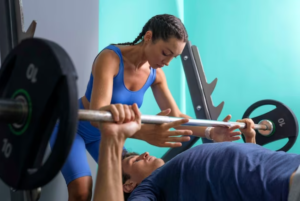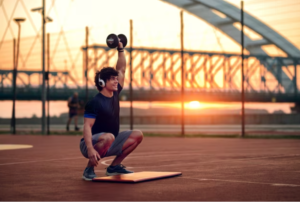Welcome to the world of top physical performance, where workouts designed for your sport are the key to unlocking it. We will talk about how important it is to adapt your training to the needs of your sport in this in-depth guide. Understanding and using workouts designed for your sport can make all the difference, whether you are a seasoned player or a fitness fanatic who wants to step up your game.
Figuring Out What Sports-Specific Training Is All About
1. Explaining Sports-Specific Workouts: Geared Training for Sports: Sports-specific workouts are made to be like the moves and demands of a certain event.
Improving Performance: These workouts improve general athletic performance by working on certain skills and energy systems.
2. Why it is important for sports:
Moving skills around: With sports-specific training, you can take the skills you learn in the gym onto the field or court.
Injury Prevention: Targeted workouts work on certain muscle groups and moving patterns, which lowers the chance of sport-related injuries.
Important Parts of Sports-Specific Workouts That Work
1. Movement Pattern Analysis: Finding Important Movements: Break the moves of the sport down into their most basic forms.
Focus on physics: To ensure your workouts are effective, you must understand the physics involved.
2. Energy System Training: Aerobic vs. Anaerobic: Determine which energy system is most important for your sport.
Customize Your Workouts: Make workouts that improve the energy system that you use during competition.
3. Skill Integration: Include sport-specific skills by doing drills that look like the skills needed in the sport.
Progressive Overload: Raise the level of difficulty and pressure over time to test your skill growth.

Different workouts for different sports
1. In football (soccer), improve your agility with cone skills, ladder exercises, and quick direction changes.
Explosive Movements: Do runs and jumps that are very high.
2. you can improve your vertical jump by doing plyometric movements in basketball.
As the game is stop-and-go, endurance drills use high-intensity speed training to make it feel like the game.
3. Swimming: Stroke-Specific Drills: Make workouts that help you get better at different swimming styles.
Long-distance swims are a good way to improve your physical health.
Creating a Customized Routine for Sports
1. Figure out what your sport requires. Talk to coaches or other experts. Help is available to help you learn the specific rules of your sport.
Look at different competition scenarios: Figure out the most important moves and energy needs during games.
2. Set clear goals: Write down your objectives. Set clear goals for your training that are special to your sport.
Measurable Goals: Set goals to see how you are doing and change your routine.
3. Structured Training Phases and Periodization for Progress: Use periodization to change the focus and volume of your workouts.
Peak at the Right Time: For the best performance, time your training stages when you have to compete.
Getting ready for peak performance
1. Food for Athletes with Specific Goals:
Balance of Macronutrients: Make sure your food meets the energy needs of your sport.
Hydration: Make sure you drink enough water, especially during hard workouts.
2. Train your mind: picture yourself succeeding. Use mental pictures of situations specific to the sport.
Pressure scenarios: To prepare your mind, act out high-pressure scenarios.
3. recovery plans Targeted Rest: Ensure your muscles in your sport get enough rest.
For active healing, cross-training is important. Do low-impact tasks to help with recovery without sacrificing skill development.
Conclusion: Getting better at sports through workouts designed for that sport
Finally, sports-specific workouts that fill the gap between training and competition are the way to become a great athlete. You can improve your ability and lower your risk of injury by making your workouts fit the needs of your sport. Follow the tips in this guide, figure out what your sport needs, and make a personalized workout plan to help you reach your full athletic potential. Prepare to confidently and accurately take over the field, court, or arena!
FAQ:
“Welcome to the best guide on Sports-Specific Workouts—an informative Frequently Asked Questions (FAQ) section that will reveal the keys to real sports success.” Find customized training plans to help you reach new levels of success, whether you are a serious athlete or just like working out. Let us dive into the world of sports-specific workouts and see how much athletic potential you have!”
Examples of sport-specificity in athletic training: making workouts fit your needs for the best results
1. Agility and quick changes of direction are important for soccer.
Consider cone skills, ladder exercises, and shuttle runs as an example of training.
2. Explosive rotating actions are a sport-specific aspect of baseball.
As an example of training, you could do flips with a medicine ball, rotated cable workouts, or bat swings.
3. Stroke methods and endurance are sport-specific aspects of swimming.
Stroke-specific drills and long runs are two examples of training.

What does a sport-specific exercise look like?
For Example, In basketball, Training for the vertical jump, An aspect specific to the sport is the power to jump high.
Do plyometric drills, box jumps, and jump squats to improve your jump height.
Building versatility for peak performance: exercises to get stronger and faster
1. Plyometric exercises: The goal is to get faster and stronger.
Like squat jumps, box jumps, and burpees.
2. The goal of strength training is to build basic power.
Squats, deadlifts, and bench pushes are some examples.
3. Agility Drills: The goal is to get better at changing directions quickly.
As an example, think about ladder drills, cone drills, and shuttle runs.
What Does Specific Sports Training Mean?
Defined: Specific sports training means making workouts specific to a certain sport’s needs.
Attempts to copy the actions, speeds, and energy systems important to the sport.
For example:
Football (soccer): Includes drills that focus on quick runs, speed, and controlling the ball.
Tennis: uses footwork drills, workouts focusing on individual strokes, and cardiovascular fitness.
By focusing on the unique skills, moves, and energy needs of an athlete’s chosen sport, sports-specific training helps them do their best in competition. See more.

